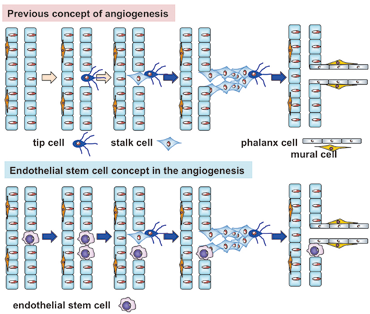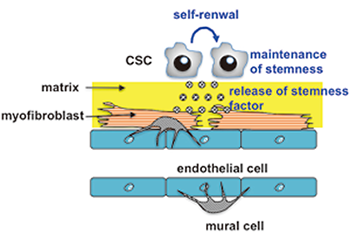It is well known that the development of normal tissues and organs requires the generation of tissue-specific cells from stem cells. The maintenance of this stem cell system also requires the generation of an appropriate microenvironment. Blood vessels are the most essential structures in tissues and organs, as without blood vessel formation, almost all tissues cannot develop (there are some exceptions). In our research group, we are analyzing the molecular mechanisms by which blood vessels form in physiological and pathological conditions, including in cancers and inflammation. We are also elucidating the mechanisms that cause stem cells to associate closely with blood vessels. Ultimately, we wish to employ our results to establish strategies that will inhibit the malignant progression of various diseases.
Our specific research projects are as follows:
I. Analysis of the molecular mechanism of blood vessel formation
1) Molecular analysis of angiogenesis, with a particular focus on the Tie1 and Tie2 receptors.
2) Physiologic and pathologic function of endothelial stem cells (ESCs).
3) Molecular characterization of arterio-venous patterning, with a particular focus on the apelin/APJ system.
II. Molecular analysis of self-renewal in normal and cancer stem cells
1) Analysis of cell cycle regulation in stem cells, with a special focus on Galectin-3 and the GINS complex.
2)Establishment of a strategy that can inhibit the formation of the vascular niche inhabited by cancer stem cells.

Figure 1. Maturation of blood vessels.

Figure 2. Endothelial stem cells (ESCs) and angiogenesis.

By using PSF1, a component of the DNA replication factor GINS, we succeeded in identifying cancer stem cells (CSCs) in the vascular niche (Nagahama, Cancer Res 2010, Matsui, Am J pathol 2013). Moreover, we found that stromal CD44 acts as a niche factor that supports the stemness of CSCs
(Kinugasa, Stem Cells 2014).